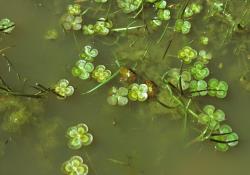Aquatic ferns, or ferns of periodically wet places. Rhizomes short- to long-creeping, branching, bearing roots at nodes, bearing septate hairs or almost glabrous. Leaves monomorphic, not articulated to rhizome, arising at nodes, with 2 (not NZ) or 4 segments terminating a long stalk, or consisting of stalk only and lacking segments, herbaceous or coriaceous, hairy (not NZ) or glabrous at maturity, circinate when young. Veins anastomosing, or greatly reduced. Sporocarps globose to ellipsoidal, sessile or stalked, hardened, usually hairy (not NZ) or glabrous, attached at or near the base of the leaf stalks, or on the rhizome near the base of the leaf stalks, opening with two valves, each containing at least two sori. Each sorus containing both mega- and microsporangia. Annulus absent. Heterosporous, spores trilete, lacking chlorophyll; one megaspore in each megasporangium and many microspores in each microsporangium. Megaspores spheroidal to slightly ellipsoidal, plain to slightly undulate; microspores spheroidal, and plain, papillate or rugulate.
A family of three genera and about 50 species (Nagalingum et al. 2008). The Marsileaceae comprises ferns that are rooted aquatic plants, either growing in water, or occupying areas that are periodically or seasonally wet. They have creeping rhizomes, and leaves with long stalks that either lack lamina segments, have just two segments, or resemble a four-leaved clover. Mega- and micro-sporangia are borne in hardened sporocarps and give rise to mega- and microspores. Spores have considerable longevity (Johnson 1985), but germination and fertilisation occur very rapidly. When moistened, the sporocarp swells and bursts, liberating a worm-like mass of gelatine carrying the sori. Spores germinate into greatly reduced gametophytes still attached to the parent spore, and fertilisation occurs within days.
Pryer (1999) and Pryer et al. (2004) showed that the heterosporous ferns, Salviniales, are one of three major lineages of "core leptosporangiate" ferns, along with tree ferns and polypod ferns. Nagalingum et al. (2008) subsequently confirmed that Salviniales is divided into two strongly supported families, the Marsileaceae and Salviniaceae, and that within Marsileaceae, there is strong support for recognition of three genera, Marsilea, Regnellidium and Pilularia. Schneider & Pryer (2002) also demonstrated that the spores of Marsileaceae are markedly different to those of Salviniaceae and all homosporous ferns. The morphology of the reproductive structures in heterosporous water ferns has been critically examined by Nagalingum et al. (2006).
The family is represented in New Zealand by one indigenous genus (Pilularia) and one fully naturalised genus (Marsilea).
Widely distributed in tropical and warmer temperate regions, and, except for Pilularia, absent from most cool temperate regions and oceanic islands. One native and one naturalised genus in New Zealand, each with a single species; none endemic.
| Category | Number |
|---|---|
| Indigenous (Non-endemic) | 1 |
| Exotic: Fully Naturalised | 1 |
| Total | 2 |




